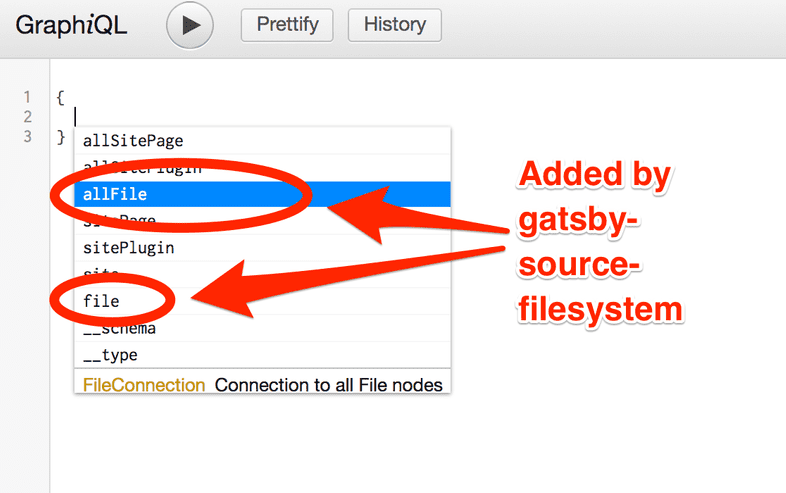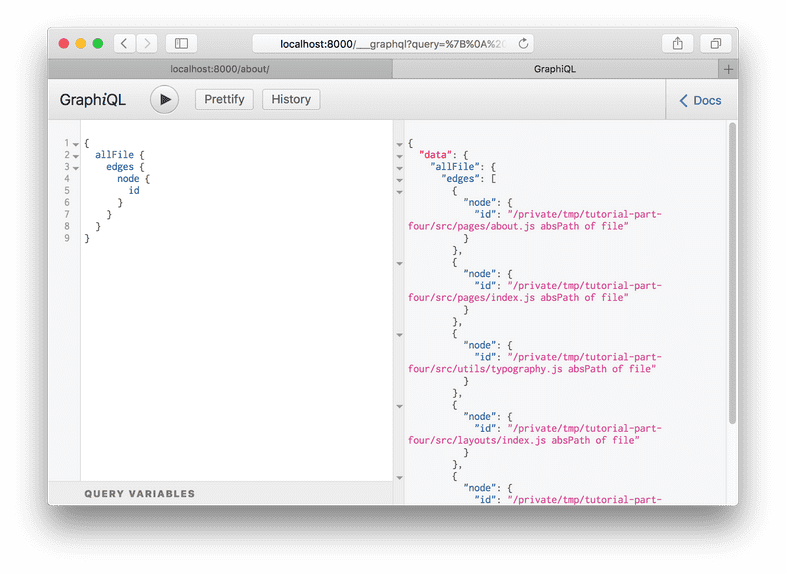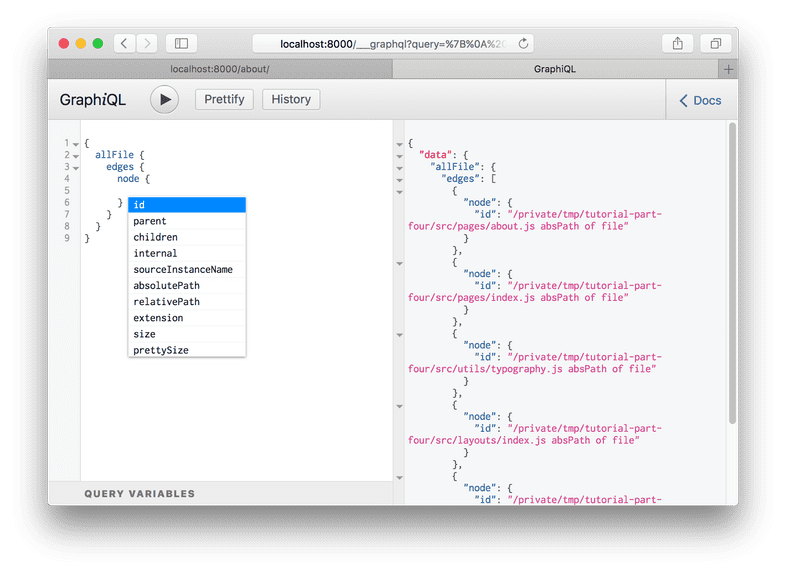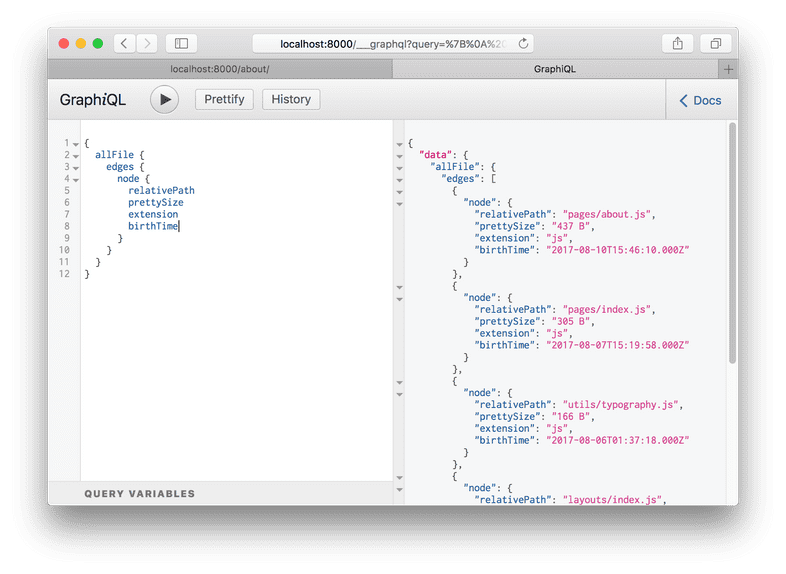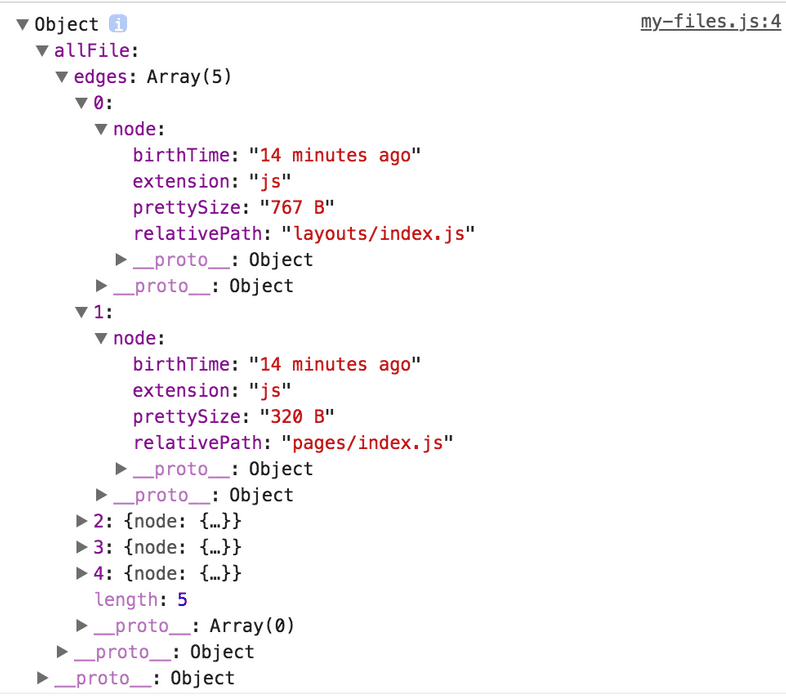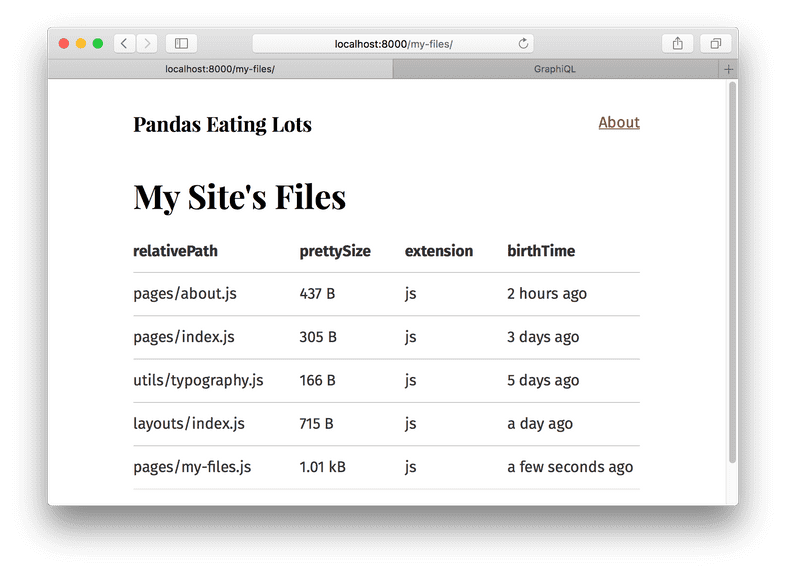Source plugins
This tutorial is part of a series about Gatsby’s data layer. Make sure you’ve gone through part 4 before continuing here.
What’s in this tutorial?
In this tutorial, you’ll be learning about how to pull data into your Gatsby site using GraphQL and source plugins. Before you learn about these plugins, however, you’ll want to know how to use something called Graph_i_QL, a tool that helps you structure your queries correctly.
Introducing Graph_i_QL
Graph_i_QL is the GraphQL integrated development environment (IDE). It’s a powerful (and all-around awesome) tool you’ll use often while building Gatsby websites.
You can access it when your site’s development server is running—normally at http://localhost:8000/___graphql.
Here you poke around the built-in Site “type” and see what fields are available
on it—including the siteMetadata object you queried earlier. Try opening
Graph_i_QL and play with your data! Press Ctrl + Space (or use Shift + Space as an alternate keyboard shortcut) to bring up
the autocomplete window and Ctrl + Enter to run the GraphQL query. You’ll be
using Graph_i_QL a lot more through the remainder of the tutorial.
Source plugins
Data in Gatsby sites can come from anywhere: APIs, databases, CMSs, local files, etc.
Source plugins fetch data from their source. E.g. the filesystem source plugin knows how to fetch data from the file system. The WordPress plugin knows how to fetch data from the WordPress API.
Add gatsby-source-filesystem and
explore how it works.
First, install the plugin at the root of the project:
npm install --save gatsby-source-filesystemThen add it to your gatsby-config.js:
module.exports = {
siteMetadata: {
title: `Pandas Eating Lots`,
},
plugins: [
{ resolve: `gatsby-source-filesystem`, options: { name: `src`, path: `${__dirname}/src/`, }, }, `gatsby-plugin-emotion`,
{
resolve: `gatsby-plugin-typography`,
options: {
pathToConfigModule: `src/utils/typography`,
},
},
],
}Save that and restart the gatsby development server. Then open up Graph_i_QL again.
If you bring up the autocomplete window, you’ll see:
Hit Enter on allFile then type Ctrl + Enter to run a
query.
Delete the id from the query and bring up the autocomplete again (Ctrl +
Space).
Try adding a number of fields to your query, pressing Ctrl + Enter each time to re-run the query. You’ll see something like this:
The result is an array of File “nodes” (node is a fancy name for an object in a “graph”). Each File object has the fields you queried for.
Build a page with a GraphQL query
Building new pages with Gatsby often starts in Graph_i_QL. You first sketch out the data query by playing in Graph_i_QL then copy this to a React page component to start building the UI.
Let’s try this.
Create a new file at src/pages/my-files.js with the allFile GraphQL query you just
created:
import React from "react"
import { graphql } from "gatsby"
import Layout from "../components/layout"
export default ({ data }) => {
console.log(data) return (
<Layout>
<div>Hello world</div>
</Layout>
)
}
export const query = graphql`
query {
allFile {
edges {
node {
relativePath
prettySize
extension
birthTime(fromNow: true)
}
}
}
}
`The console.log(data) line is highlighted above. It’s often helpful when
creating a new component to console out the data you’re getting from the GraphQL query
so you can explore the data in your browser console while building the UI.
If you visit the new page at /my-files/ and open up your browser console
you will see something like:
The shape of the data matches the shape of the GraphQL query.
Add some code to your component to print out the File data.
import React from "react"
import { graphql } from "gatsby"
import Layout from "../components/layout"
export default ({ data }) => {
console.log(data)
return (
<Layout>
<div> <h1>My Site's Files</h1> <table> <thead> <tr> <th>relativePath</th> <th>prettySize</th> <th>extension</th> <th>birthTime</th> </tr> </thead> <tbody> {data.allFile.edges.map(({ node }, index) => ( <tr key={index}> <td>{node.relativePath}</td> <td>{node.prettySize}</td> <td>{node.extension}</td> <td>{node.birthTime}</td> </tr> ))} </tbody> </table> </div> </Layout>
)
}
export const query = graphql`
query {
allFile {
edges {
node {
relativePath
prettySize
extension
birthTime(fromNow: true)
}
}
}
}
`And… 😲
What’s coming next?
Now you’ve learned how source plugins bring data into Gatsby’s data system. In the next tutorial, you’ll learn how transformer plugins transform the raw content brought by source plugins. The combination of source plugins and transformer plugins can handle all data sourcing and data transformation you might need when building a Gatsby site. Learn about transformer plugins in part six of the tutorial.
Edit this page on GitHub
